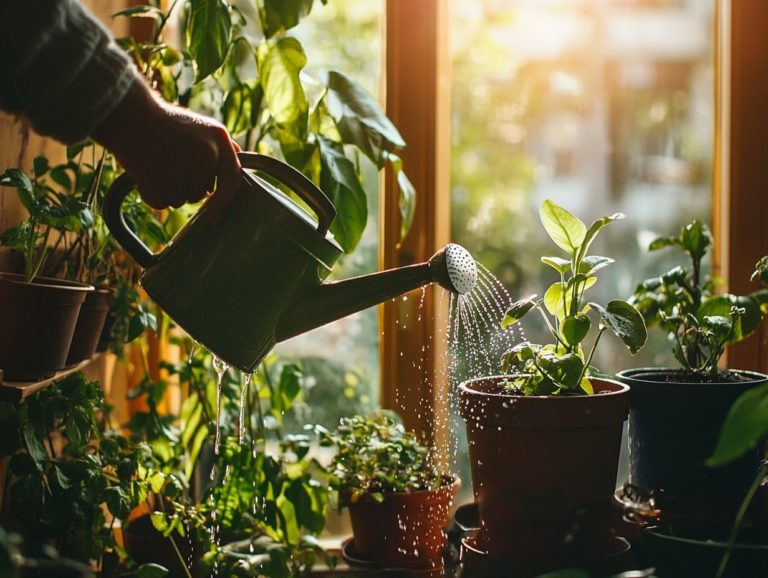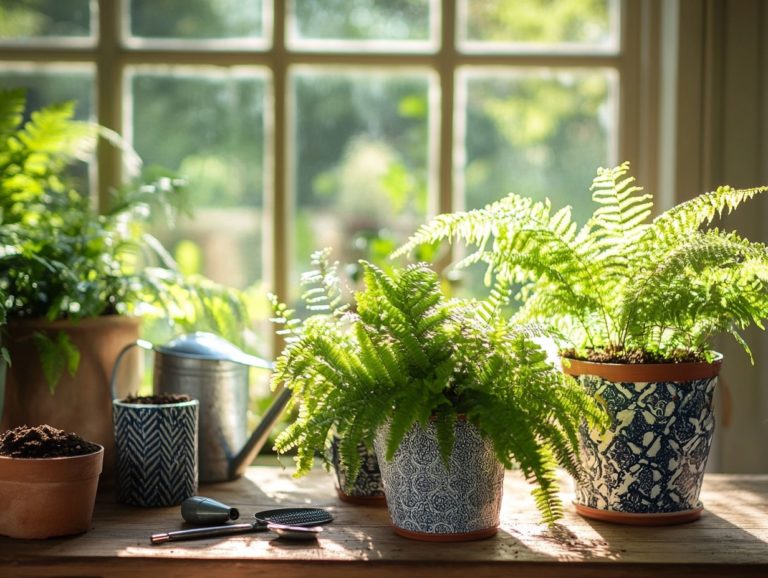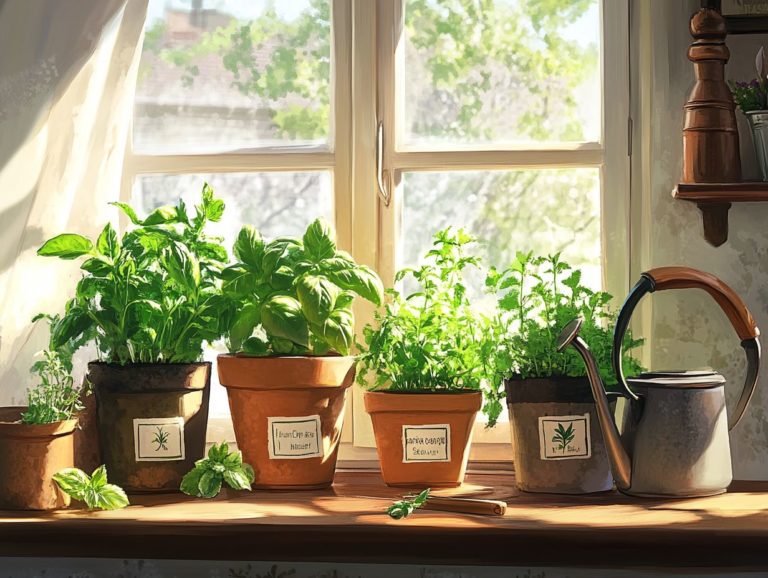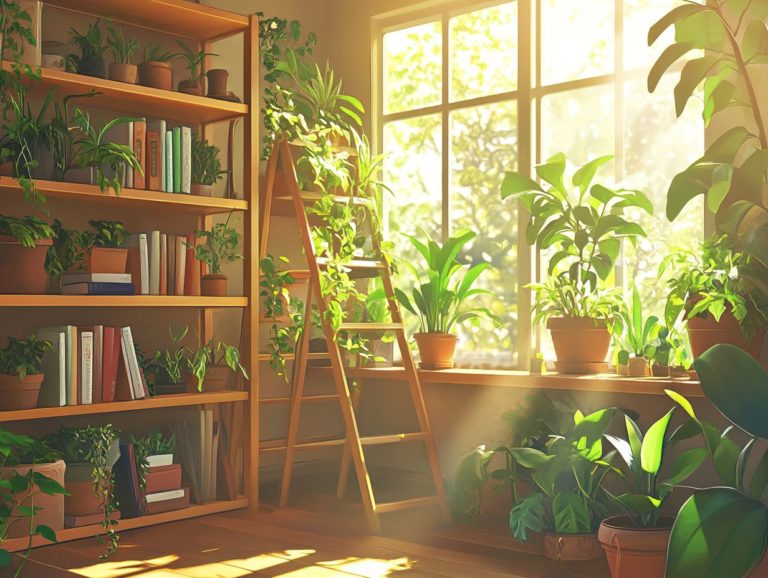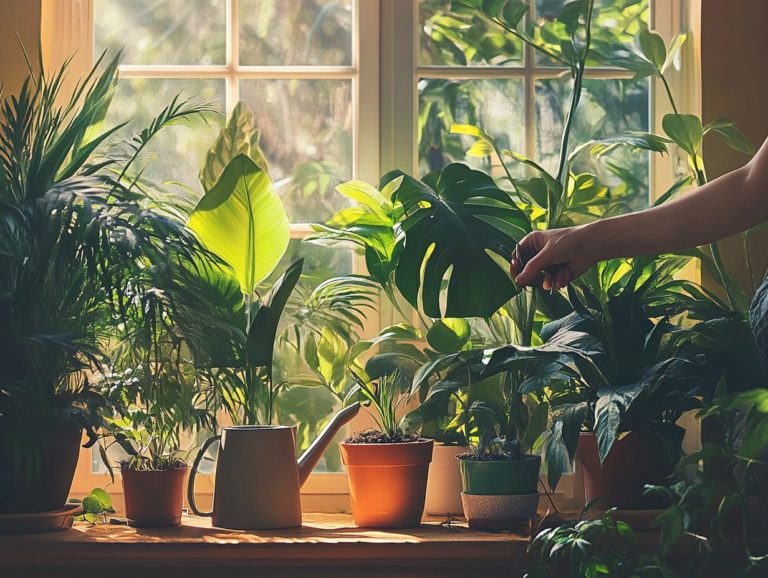What are the Best Indoor Plants for Air Quality?
Indoor air quality is often overlooked, yet it plays an important part in your overall health and well-being. Don t wait! Discover how you can immediately improve your air quality with simple additions to your home, like indoor plants.
Poor indoor air can lead to a range of issues, from pesky allergies to chronic respiratory problems. The good news? A simple addition of indoor plants, such as spider plants and peace lilies, can significantly enhance your air quality.
Let s explore the dangers of indoor air pollution and how you can use plants to combat it! This article highlights the impact of indoor air pollution and common toxins, the benefits of specific plants, and provides tips for selection and care, all aimed at helping you create a healthier living space.
Dive in to discover how you can breathe easier at home!
Contents
- Key Takeaways:
- The Importance of Indoor Air Quality
- Benefits of Indoor Plants for Air Quality
- Top Indoor Plants for Air Quality
- Caring for Indoor Plants
- Choosing the Right Plants for Your Space
- Frequently Asked Questions
- What are the Best Indoor Plants for Air Quality?
- Do these plants have any specific benefits for air quality?
- How do these plants improve air quality?
- Can these indoor plants also improve the overall aesthetic of my indoor space?
- Do these plants have a high maintenance level?
- Are there any other benefits to having these air-purifying plants in my home?
Key Takeaways:

- Plants are essential for cleaner indoor air!
- Some of the best indoor plants for air quality include spider plants, peace lilies, English ivy, and Chinese evergreens, as they filter out common indoor pollutants.
- To keep your indoor plants healthy and thriving, provide proper care and consider factors like lighting and humidity levels in your space.
The Importance of Indoor Air Quality
Indoor air quality is a vital part of your living environment. It influences not only your comfort but also your health and well-being. Research, including findings from the NASA Clean Air Survey, reveals that indoor air can often be more polluted than outdoor air.
It frequently harbors common toxins such as formaldehyde, benzene, xylene, and trichloroethylene. These harmful air pollutants can cause serious health issues, underscoring the importance of understanding and enhancing the quality of the air you breathe indoors.
Understanding the Impact of Indoor Air Pollution
Indoor air pollution can significantly impact your health, stemming from exposure to toxic pollutants that lurk within your own home or workplace. These harmful substances come from many sources, including the cleaning products you use, building materials, and even common activities like cooking or smoking.
Common culprits, such as volatile organic compounds (VOCs) chemicals found in many products that can affect air quality formaldehyde, and particulate matter, can accumulate in your indoor environment, degrading air quality. This compromised atmosphere has been associated with respiratory issues, heightened allergy symptoms, and even long-term health concerns like asthma and other chronic conditions.
You might also find yourself battling headaches, fatigue, or irritation of the eyes, skin, or throat, which highlights just how crucial it is to prioritize clean air in your living and working spaces.
Benefits of Indoor Plants for Air Quality
Indoor plants provide a simple way to enhance indoor air quality, as highlighted by the NASA Clean Air Survey. This research reveals that specific plant species, such as golden pothos and bamboo palms, excel at purifying the air by absorbing harmful toxins and releasing fresh oxygen.
This natural process not only elevates the aesthetic charm of your space but also plays a crucial role in fostering a healthier living environment with indoor plants.
How Plants Can Improve Air Quality

Plants play a crucial role in enhancing your air quality by absorbing carbon dioxide and releasing oxygen through the process plants use to turn sunlight into energy, with chlorophyll, a green pigment in plants that helps them absorb sunlight, as their helping hand.
But that’s just the beginning. These plants also filter out harmful pollutants that infiltrate indoor spaces. Through their roots and leaves, they absorb nasty chemicals like formaldehyde, benzene, and trichloroethylene, all while contributing to a healthier living environment. If you’re looking for options, check out the best indoor plants for low light. The intricate structures of their leaves effectively capture dust and smoke, while their roots work diligently to break down contaminants in the soil.
This dual action not only detoxifies the air you breathe but also creates a calming atmosphere that can lift your spirits and enhance your overall well-being. Start adding plants to your space today for a cleaner, healthier home!
Top Indoor Plants for Air Quality
When enhancing your indoor air quality, certain plants truly shine with their exceptional air purification abilities. The spider plant, Boston fern, snake plant, and peace lily are among the best, renowned for their efficiency in filtering toxins from the air.
This isn t just hearsay; various studies, including the notable NASA Clean Air Survey, have documented their impressive effectiveness.
Plants that are Effective at Purifying Air
Among the most effective plants for air purification are the Boston fern, snake plant, ZZ plant, peace lily, and Aglaonema. Each of these botanical wonders showcases the ability to filter harmful substances like formaldehyde and trichloroethylene from the air.
The Boston fern thrives in humid environments and prefers indirect light, making it an ideal choice for your bathroom or kitchen. Its lush foliage not only beautifies your space but also excels at removing indoor pollutants.
Then there s the snake plant, known for its striking upright leaves. This resilient gem can tolerate lower light conditions and requires minimal water. Plus, it converts carbon dioxide into oxygen at night making it a unique addition to your bedroom.
The ZZ plant, celebrated for its glossy leaves, flourishes in low-light situations and is incredibly forgiving when it comes to watering. Its knack for filtering toxins truly enhances your indoor air quality.
The peace lily also purifies the air by absorbing harmful substances and signals when it needs attention with its droopy leaves.
Together, these plants transform your indoor space into an oasis while actively contributing to a cleaner living environment filled with health benefits. If you’re new to gardening, you might want to explore the best indoor plants for beginners to get started.
Caring for Indoor Plants
Caring for your indoor plants is crucial for reaping their full benefits in enhancing air quality through effective air purification. You need to pay attention to various factors, such as maintenance level, watering needs, and light exposure, to ensure they thrive and last for years to come.
Tips for Keeping Indoor Plants Healthy
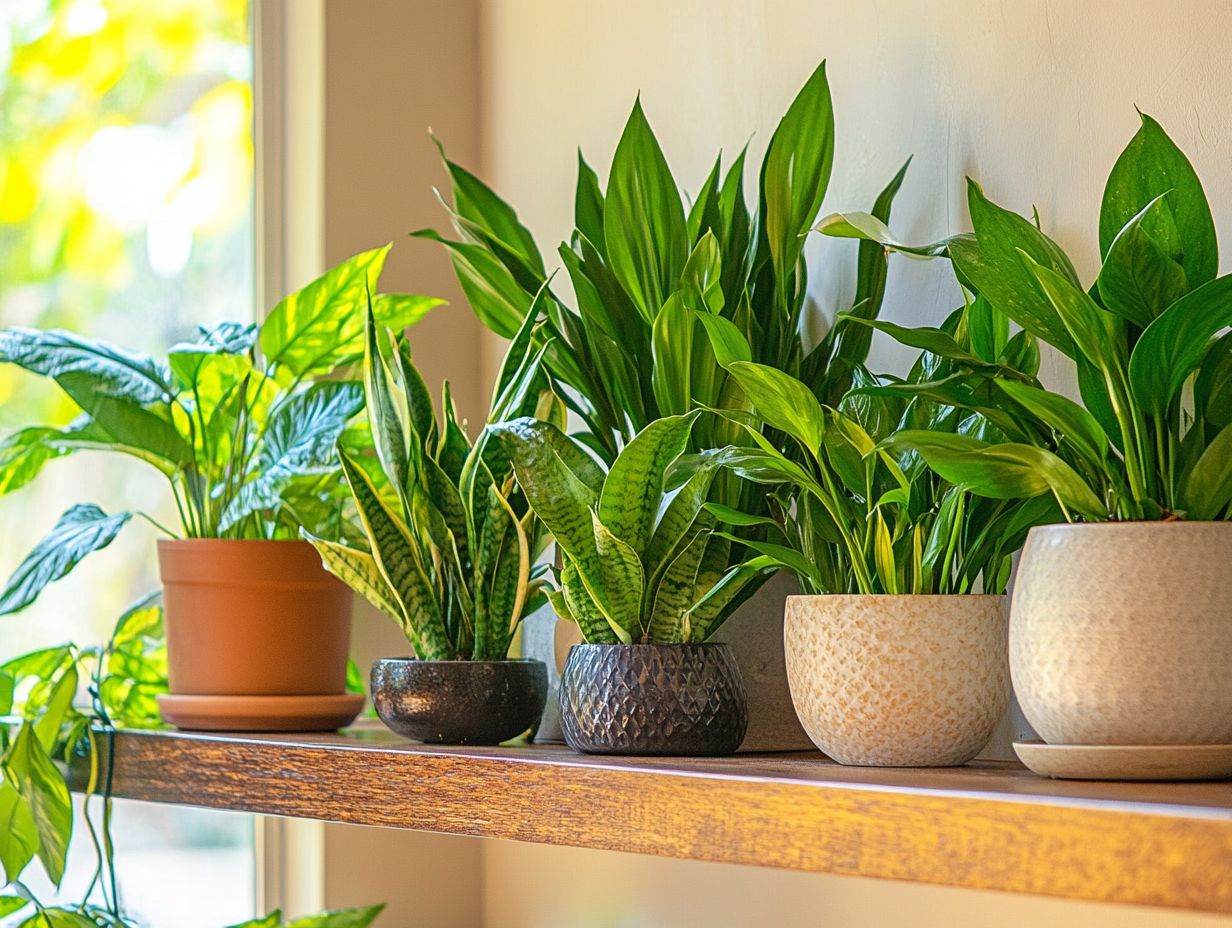
To keep your indoor plants thriving, it’s essential to follow specific tips regarding watering, light conditions, and pest management. Neglecting these factors can stress your plants, ultimately hindering their ability to effectively purify the air.
For instance, over-watering is a common pitfall that often leads to root rot, while under-watering leaves your plants parched and drooping. It’s also vital to understand the unique light requirements of each plant species, as inadequate light can stunt growth and diminish their air quality-enhancing benefits.
Regularly inspecting for pests and taking prompt action can prevent infestations that could compromise the health and air-purifying prowess of your green companions. A well-cared-for indoor garden not only elevates the aesthetic of your space but also significantly improves the overall air quality.
Wondering which plants are best for your home? Here are some top choices!
Don’t wait! Start incorporating plants into your living space and share your experiences with indoor plants to foster community engagement.
Choosing the Right Plants for Your Space
Selecting the right plants for your space is essential for achieving a thriving indoor garden. Consider factors like light availability, dimensions of your area, and specific air quality needs you’re aiming to improve.
Making informed choices sets the foundation for your gardening success.
Considerations for Different Conditions
When selecting indoor plants, it’s crucial to think about the specific conditions in your space, including light availability, humidity levels, and the need to filter common toxins. Understanding these elements can significantly enhance plant health and, in turn, improve the air quality in your home.
In low-light areas, choosing plants like snake plants or golden pothos allows them to thrive with minimal sunlight. In high humidity, consider options like peace lilies or ferns; they flourish in those conditions and help reduce airborne toxins.
If your environment is predominantly dry, robust specimens like succulents or cacti are ideal, as they adapt well to arid conditions and require less frequent watering.
This selection process ensures your plants not only survive but thrive, enriching your indoor ecosystem and enhancing your overall well-being.
Discover how to choose the right plants for your indoor space with this video!
Frequently Asked Questions
What are the Best Indoor Plants for Air Quality?
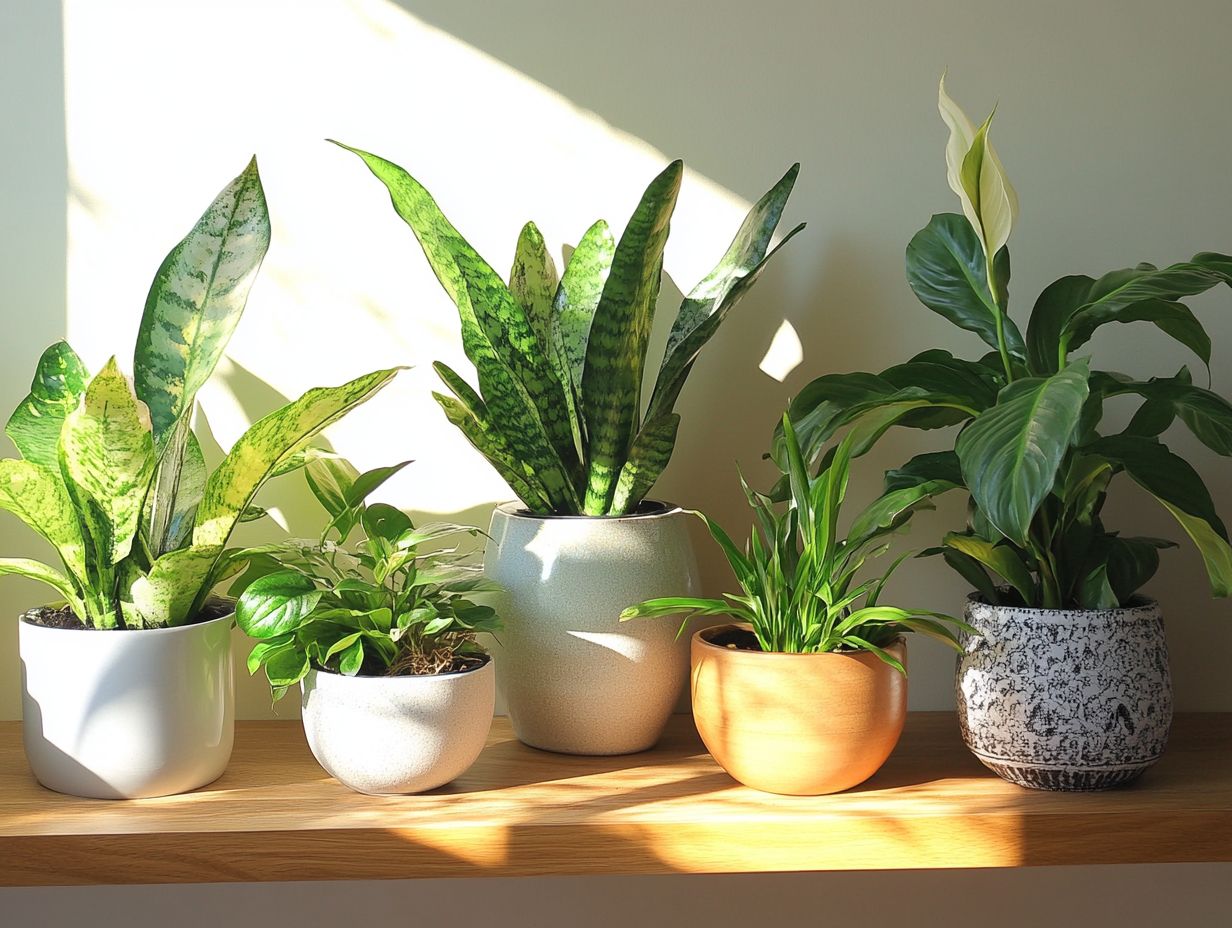
The best indoor plants for air quality include pothos, snake plant, peace lily, spider plant, Boston fern, and aloe vera.
Do these plants have any specific benefits for air quality?
Yes, these plants remove harmful toxins like formaldehyde, benzene, and trichloroethylene from the air, boosting your indoor air quality for a fresher, healthier home!
How do these plants improve air quality?
These plants absorb toxins through their leaves and roots, converting them into oxygen and other harmless byproducts through photosynthesis, a process that plants use to turn sunlight into energy.
Can these indoor plants also improve the overall aesthetic of my indoor space?
Absolutely! These plants not only purify the air but also add a touch of greenery and life to any indoor space.
Do these plants have a high maintenance level?
No, these plants are low maintenance, needing only watering once a week and occasional trimming and repotting, making them ideal for indoor gardening.
Are there any other benefits to having these air-purifying plants in my home?
Aside from improving air quality and enhancing your space’s aesthetic, plants like the spider plant, Boston fern, and snake plant can also reduce stress levels and boost overall mood and productivity.
Explore our range of indoor plants and transform your space now!

